Cub cadet PRO Z 100 User Manual
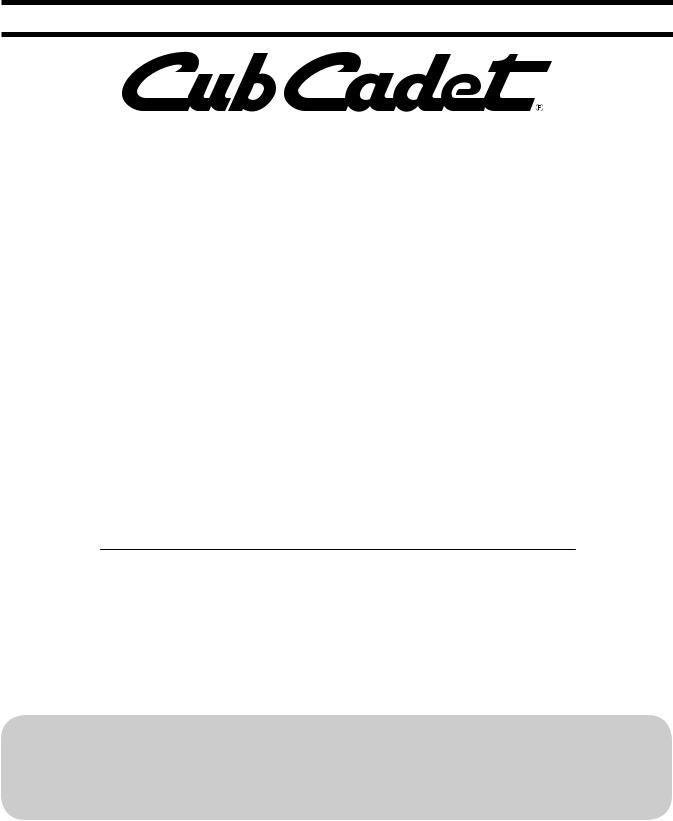
Safe Operation Practices • Set-Up • Operation • Service • Troubleshooting
Operator’s Manual
Zero-Turn Rider
Pro Z 100
Lapbar
Table of Contents
Safe Operation Practices |
......................................... 2 |
Troubleshooting..................................................... |
25 |
|
Assembly & Set-Up................................................... |
9 |
Replacement Parts................................................. |
26 |
|
Controls & Operation.............................................. |
11 |
Attachments & Accessories................................... |
26 |
|
Service...................................................................... |
18 |
Warranties.............................................................. |
30 |
|
|
|
|
|
|
 WARNING
WARNING
READ AND FOLLOW ALL SAFETY RULES AND INSTRUCTIONS IN THIS MANUAL
BEFORE ATTEMPTING TO OPERATE THIS MACHINE.
FAILURE TO COMPLY WITH THESE INSTRUCTIONS MAY RESULT IN PERSONAL INJURY.
NOTE: This Operator’s Manual covers several models. Features may vary by model. Not all features in this manual are applicable to all models and the model depicted may differ from yours.
Printed In USA |
Form No. 769-11036B |
|
(January 19, 2016) |
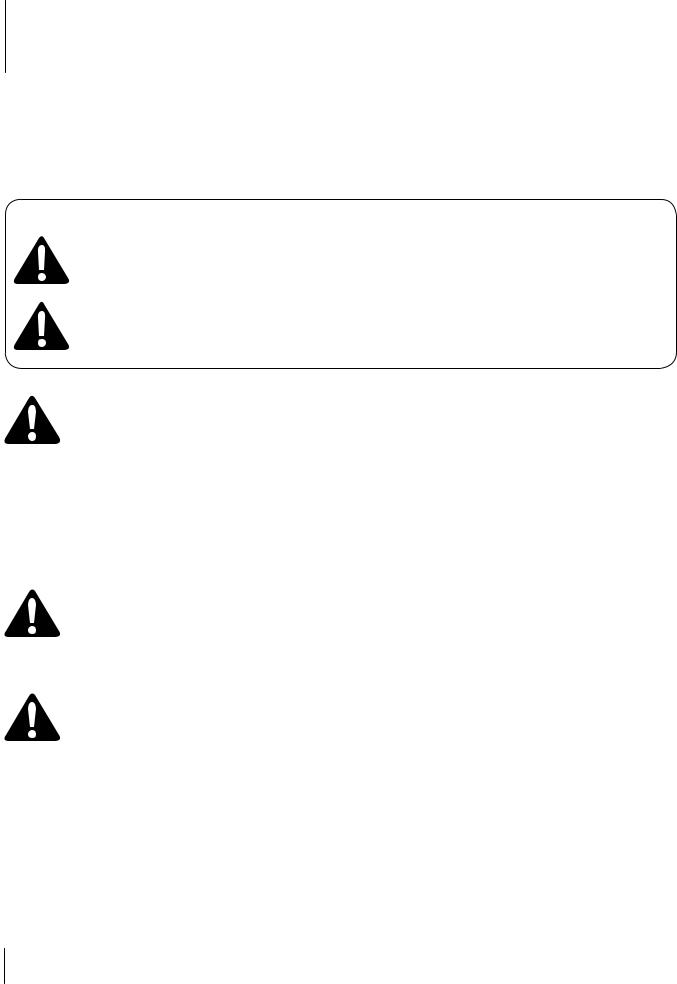
Important Safe Operation Practices |
2 |
|
|
|
|
 WARNING! This symbol points out important safety instructions which, if not followed, could endanger the personal safety and/or property of yourself and others. Read and follow
WARNING! This symbol points out important safety instructions which, if not followed, could endanger the personal safety and/or property of yourself and others. Read and follow
all instructions in this manual before attempting to operate this machine. Failure to comply with these instructions may result in personal injury.
When you see this symbol, HEED ITS WARNING!
CALIFORNIA PROPOSITION 65
WARNING! Engine Exhaust, some of its constituents, and certain vehicle components contain or emit chemicals known to the State of California to cause cancer and birth defects or other reproductive harm.
WARNING! Battery posts, terminals, and related accessories contain lead and lead compounds, chemicals known to the State of California to cause cancer and reproductive harm. Wash hands after handling.
WARNING! This machine is equipped with an internal combustion engine and should not be used on or near any unimproved forest-covered, brush-covered or grass-covered land unless the engine’s exhaust system is equipped with a spark arrestor meeting applicable local or state laws (if any). If a spark arrestor is used, it should be maintained in effective working order by the operator. In the state of California the above is required by law (Section 4442 of the California Public Resources Code). Other states may have similar laws. Federal laws apply on federal lands. A spark arrestor for the muffler is available through your nearest engine authorized service dealer or contact the service department, P.O. Box 361131, Cleveland, Ohio 44136-0019.
This spark ignition system complies with Canadian ICES-002.
DANGER! The engine manufacturer has supplied an engine owner’s manual for information regarding US Environmental Protection Agency (EPA) and California Air resources Board (CARB) regulations relating to emission control systems, maintenance, and warranty. Making any unauthorized alterations or modifications to the engine, fuel, or venting systems may violate EPA and/or CARB regulations. Further information may be obtained from the engine manufacturer.
DANGER! This machine was built to be operated according to the safe operation practices in this manual. As with any type of power equipment, carelessness or error on the part of the operator can result in serious injury. This machine is capable of amputating hands and feet and throwing objects. Failure to observe the following safety instructions could result in serious injury or death.
2
Training
1.Read the Operator’s manual and other training material. If the operator(s) or mechanic(s) cannot read English it is the owner’s responsibility to explain this material to them.
2.Become familiar with the safe operation of the machine, operator controls, and safety signs.
3.All operators and mechanics should be trained to operate or service the equipment. The owner is responsible for training them.
4.Never let children under the age of 16 or untrained people operate or service the equipment. Local regulations may further restrict the age of the operator.
5.The owner/operator can prevent and is responsible for accidents or injuries occurring to them, other people or property.
General Operation
1.Read, understand, and follow all instructions on the machine and in the manual(s) before attempting to assemble and operate. Keep this manual in a safe place for future and regular reference by each operator and for ordering replacement parts.
2.Be familiar with all controls and their proper operation. Know how to stop the machine and disengage the controls quickly.
3.Do not allow anyone to operate or maintain this machine who has not read the manual. Never permit children under the age of 16 to operate this machine.
4.Do not remove any shields, guards, labels or safety devices. If a shield, guard, label or safety device is damaged or does not function, repair or replace it before operating the machine.
5.To help avoid blade contact or a thrown object injury, keep bystanders, helpers, children and pets at least 75 feet from the machine while it is in operation. Stop machine if anyone enters the area.
6.Thoroughly inspect the area where the equipment is to be used. Remove all stones, sticks, wire, bones, toys, and other foreign objects that could be picked up and thrown by the blade(s). Thrown objects can cause serious personal injury.
7.Evaluate the terrain to determine what accessories and attachments are needed to properly and safely perform the job. Only use accessories and attachments approved by the machine manufacturer.
8.Plan your mowing pattern to avoid discharge of material toward roads, sidewalks, bystanders and the like. Also, avoid discharging material against a wall or obstruction which may cause discharged material to ricochet back toward the operator.
9.Always wear appropriate clothing and personal protective equipment (e.g. safety glasses, long pants, gloves, hearing protection , safety shoes, hard hat) when operating or maintaining this machine. Long hair, loose fitting clothing or jewelry may get entangled in moving parts. Follow all federal, state and local guidelines regarding the use of personal protective equipment.
10.Be aware of the mower and attachment discharge direction and do not point it at anyone. Do not operate the mower without the discharge cover or entire grass catcher in its proper place.
11.Do not put hands or feet near rotating parts or under the cutting deck. Contact with the blade(s) can amputate hands and feet.
12.A missing or damaged discharge cover can cause blade contact or thrown object injuries.
13.Stop the blade(s) when crossing gravel drives, walks, or roads and while not cutting grass.
14.Watch for traffic when operating near or crossing roadways. This machine is not intended for use on any public roadway.
15.Do not operate the machine while under the influence of alcohol or drugs.
16.Mow only in daylight or good artificial light.
17.Never carry passengers.
18.Back up slowly. Always look down and behind before and while backing to avoid a back-over accident.
19.Slow down before turning. Operate the machine smoothly. Avoid erratic operation and excessive speed. Be aware of your direction of travel to avoid accidents.
20.Disengage blade(s), set parking brake, stop engine and wait until the blade(s) come to a complete stop before removing grass catcher, emptying grass, unclogging chute, removing any grass or debris, or making any adjustments.
21.Never leave a running machine unattended. Always stop on level ground, turn off blade(s), place drive speed control levers in neutral, set parking brake, stop engine and remove key before leaving the operator position.
22.Use extra care when loading or unloading the machine on a trailer or truck. The machine should not be driven on unstable, unsecured or inadequate ramps because the machine could tip over causing serious personal injury.
23.Check overhead clearances carefully before driving under low hanging tree branches, wires, door openings etc., where the operator and/or ROPS may be struck which could result in serious injury and/or machine tip over.
24.Muffler and engine become hot and can cause a burn. Do not touch.
25.Disengage the blades, set the parking brake to the ‘ON’ position and make sure the speed control lever are in the neutral position before attempting to start the engine. Only start the engine from the operator’s position.
26.Do not attempt to mow unusually tall, dry grass (e.g., pasture) or piles of dry leaves. Dry grass or leaves may contact the engine exhaust and/or build up on the mower deck presenting a potential fire hazard.
27.Do not stop or park the machine over dry leaves, grass, debris or other combustible material.
28.Never attempt to operate the machine without the mowing deck attached; the machine could tip over.
29.Keep the machine and especially the engine exhaust system and hydraulic components clean and free of grease, grass and leaves to reduce the potential for overheating and fire.
30.Allow the machine to cool at least 5 minutes before storing.
31.Use only accessories and attachments approved for this machine by the machine manufacturer. Read, understand and follow all instructions provided with the approved accessory or attachment.
Section 2 — Important Safe Operation Practices |
|
3 |
|
||
|
|
|
32.Data indicates that operators, age 60 years and above, are involved in a large percentage of riding mower-related injuries. Operators should evaluate their ability to operate this machine safely enough to protect themselves and others from serious injury.
33.Do not operate or start machine if there is fuel or oil leaks; repair immediately.
34.When looking for oil leaks, never run your hand over hydraulic hoses, lines or fittings. Never tighten or adjust hydraulic hoses, lines or fittings while the system is under pressure. If high-pressure oil penetrates the skin seek immediate medical attention or gangrene and permanent damage may result. Do not check for hydraulic leaks with your hands, use paper or cardboard instead. Wear gloves and safety glasses when checking for leaks.
35.Do not operate machines that have been damaged or have not been properly maintained. If the machine has been damaged, then have it repaired.
36.When operating this machine in the forward direction, do not allow the speed control levers to return to the neutral position on their own. Always operate them smoothly and avoid any sudden movements of the levers when starting or stopping.
37.If situations occur which are not covered in this manual use care and good judgement. Contact your customer service representative for assistance.
Slope Operation
Slopes are a major factor related to loss of control and tip-over accidents that can result in severe injury or death. All slopes require extra caution. If you cannot back up the slope or if you feel uneasy on it, do not mow it or drive on the slope.
For your safety, use the slope gauge included as part of this manual to measure slopes before operating this machine on a sloped or hilly area. If the slope is greater than 20 degrees as
shown on the slope gauge, do not operate this machine on that area or serious injury could result.
Do:
1.Mow across slopes, not up and down. Exercise extreme caution when changing direction on slopes.
2.Watch for holes, ruts, bumps, rocks, or other hidden objects. Uneven terrain could overturn the machine. Tall grass can hide obstacles.
3.Use slow speed. Choose a low enough speed so that you will not have to stop while on the slope. Avoid starting or stopping on a slope. If the tires are unable to maintain traction, disengage the blades and proceed slowly and carefully straight down the slope.
4.Keep all movements on the slopes slow and gradual. Do not make sudden changes in speed or direction. Rapid acceleration could cause the front of the machine to lift and rapidly flip over backwards, which could cause serious injury or death.
5.Follow the manufacturer’s recommendations for wheel weights or counterweights to improve stability.
6.Use extra care with grass catchers or other attachments. These can change the stability of the machine.
Do Not:
1.Do not turn on slopes unless necessary; then turn slowly uphill and use extra care while turning.
2.Do not mow near drop-offs, ditches or embankments. The machine could suddenly turn over if a wheel is over the edge of a cliff, ditch, or if an edge caves in.
4 |
|
Section 2 — Important Safe Operation Practices |
|
||
|
|
|
3.Do not operate on slopes or near the edge of water such as a lake, pond, river or stream where the machine could slip, tip or roll-over into the water.
4.Do not try to stabilize the machine by putting your foot on the ground.
5.Do not use a grass catcher on slopes steeper than 15 degrees.
6.Do not mow on wet grass. Reduced traction could cause sliding and/or loss of control.
7.Do not tow heavy pull behind attachments (e.g. loaded dump cart, lawn roller, etc.) on slopes greater than 5 degrees. When going downhill, the extra weight tends to push the machine and may cause loss of traction and loss of control (e.g. machine may speed up, braking and
steering ability are reduced, attachment may jack-knife and cause machine to overturn).
Children
1.Tragic accidents can occur if the operator is not alert to the presence of children. Children are often attracted to the machine and the mowing activity. They do not understand the dangers. Never assume that children will remain where you last saw them.
a.Keep children out of the mowing area and in watchful care of a responsible adult other than the operator.
b.Be alert and turn machine off if a child enters the area.
c.Always look behind and down for small children. Use slow speed.
d.Never carry children, even with the blade(s) shut off. They may fall off and be seriously injured or interfere with safe machine operation.
e.Use extreme care when approaching blind corners, doorways, shrubs, trees or other objects that may block your vision of a child who may run into the path of the machine.
f.To avoid back-over accidents, always disengage blades before traveling in reverse.
g.Keep children away from hot or running engines. They can suffer burns from a hot muffler.
h.Remove key when machine is unattended to prevent unauthorized operation.
2.Never allow children under 16 years of age to operate this machine. Children 16 and over should read and understand the instructions and safe operation practices in this manual and on the machine and should be trained and supervised by an adult.
Towing
1.Do not tow heavy tow-behind attachments (e.g. loaded dump cart, lawn roller, etc.) on slopes greater than 5 degrees.
2.Tow only with a machine that has a hitch designed for towing. Do not attach towed equipment except at the hitch point.
3.Follow the manufacturer’s recommendation for weight limits for towed equipment and towing on slopes.
4.Never allow children or others in or on towed equipment.
5.On slopes, the weight of the towed equipment may cause loss of traction and loss of control.
6.Travel slowly and allow extra distance to stop.
7.Make wide turns to avoid jack knifing
Transporting Machines
1.This machine is not intended for use on public roads. Machines operated on public roads must comply with state & local ordinances, SAE J137, and ANSI/ASABE S279 (lighting and marking requirements).
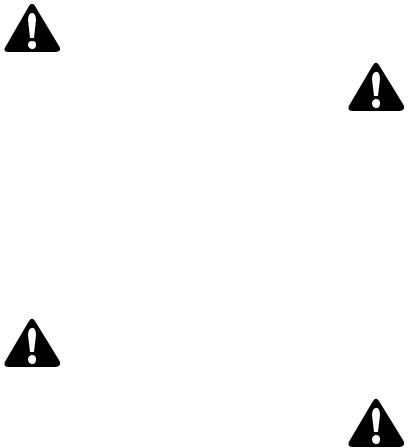
2.Use care when loading or unloading machines onto trailers and trucks.
3.If ramps are used, they must be full width, stable, have an adequate capacity rating and be secured to the trailer or truck. Ramp angle should not exceed 15 degrees and trailer or truck should be parked on level terrain.
4.Machines must be secured onto trailers and trucks with straps, chains, cables, ropes, or other means deemed adequate for that purpose. The front and rear of the machines must be secured to the trailer or truck in both the lateral and vertical directions.
Operator Protective System (OPS)
1.This machine is equipped with an Operator Protective System (OPS), which includes:
a.A Roll Over Protective Structure (ROPS) of the fixed or folding configuration.
b.Seat belt assembly with retractable function.
2.ROPS are structures designed to provide a crush-resistant space for the operator when properly seat-belted within the designated seating area of the machine in the event of a machine tip-over or roll-over. Folding ROPS shall be used in their fully upright and locked configurations except in those circumstances whereby they need to be momentarily folded-down to avoid contact with items such as tree limbs, clothes lines, guy wires, utility poles, buildings, etc. At other times and conditions, ROPS shall be in their fully upright and locked configurations.
DANGER: Damaged ROPS must be replaced prior to operator use!
3. Seat belts shall be used and shall be properly fastened about the operator’s waist at all times,
except when the ROPS are:
a.Not properly installed and/or not properly secured onto the machine.
b.Damaged in such manner that their structural integrity has been compromised.
c.Not in their fully upright and locked position.
4.Seat belts are attached to the movable portion of the seat when suspension seats are utilized, and therefore the seatmounting base must be secured to its pivot means and the pivot means latched to the frame of the machine. Seat belts are attached to the seat or the frame of the machine when non-suspension (standard) seats are provided, however, if a suspension kit is added to a seat, the seat belt must be attached to the movable portion of the seat or suspension mechanism, the seat-mounting base must be secured to its pivot means, and the pivot means be latched to the frame of the machine.
DANGER: If ROPS are folded down or missing, seat belts shall not be fastened. Worn or damaged seat belt assemblies must be replaced prior to operator use.
5.A brush guard or canopy may deflect tree limbs, clothes lines, and other obstacles that otherwise could come in contact with the ROPS. Contact of ROPS and/or canopies by items such as tree limbs, clothes lines, guy wires, and buildings, could create hazardous conditions whereby the machine could experience a tip-over or roll-over. A
canopy may provide protection for the operator from some environmental exposure (sunlight, rain, etc.).
6.The ROPS and seat belt are integral parts of this machine and should not be tampered with, modified in any manner, or removed.
7.Inspect the ROPS and seat belt assemblies on a regular basis for damage and improper operation. Replace all components that are damaged or are not functioning properly with authorized replacement parts.
8.The ROPS extends above and behind the operator position, and therefore the operator must be aware of potential contact of the ROPS with items such as trees, buildings, doorways, clothes lines, utility wires, etc., that could cause the machine to tip-over or rollover. Use caution in (or avoid) areas where the ROPS could come in contact with any structures, trees, etc.
9.Inspect the ROPS and seat belt assemblies on a regular basis for damage and improper operation. Replace all components that are damaged or are not functioning properly with authorized replacement parts.
10.Failure to use the seat belt properly could result in serious injury or death if an accidental overturn occurs. In order for the ROPS to be effective, the seat belt must be securely fastened around the operator at all times when the operator is on the machine. Contact with the ROPS during an overturn could cause serious injury or death.
11.The ROPS will not prevent machine from tip-overs or roll-overs.
12.Do not assume ROPS will protect you in a tip-over or rollover. Injuries may still occur.
Hydraulic Devices and Systems
Hydraulic fluid escaping under pressure may have sufficient force to penetrate skin and cause serious injury. If foreign fluid is injected into the skin or eyes, see immediate medical attention or gangrene and permanent damage may result.
WARNING: Keep body and hands away from pinholes or nozzles that could inject hydraulic fluid under high pressure. Use paper or cardboard, not
your hands, to search for leaks! Wear gloves and safety glasses.
Safely relieve all pressure in the system before performing any work on the system, and make sure that:
•The ignition switch is OFF
•The key is removed
•The engine spark plug wire(s) removed
•All connections to the negative terminal of the battery are removed
•The park brake is set
•All by-pass valves, if so equipped, are open
•Hydraulic controls are actuated to release pressure on pumps, cylinders, etc. If “float” positions are available, they should be used.
After the above operations are completed, it should be safe to begin disconnecting the lines or components. It is still a good idea to cover the connection with a cloth shield and then gently loosen connections.
WARNING: Make sure all hydraulic fluid connections are tight and all hydraulic hoses and lines are in good condition before applying pressure to the system.
Section 2 — Important Safe Operation Practices |
|
5 |
|
||
|
|
|
Service
Safe Handling of fuel
1.To avoid personal injury or property damage use extreme care in handling fuel. Fuel is extremely flammable and the vapors are explosive. Serious personal injury can occur when fuel is spilled on yourself or your clothes which can ignite. Wash your skin and change your closes immediately.
a.Use only approved containers.
b.Never fill containers inside a vehicle or a truck or trailer bed with a carpeted or plastic liner. Always place containers on the ground away from your vehicle before fueling.
c.When practical, remove machines from the truck or trailer and refuel it on the ground. If this is not possible, then refuel equipment on a trailer with a portable container rather than from a fuel dispenser nozzle.
d.Keep nozzle in contact with the rim of the fuel tank or container opening at all times until fueling is complete. Do not use a nozzle lock-open device.
e.Extinguish all cigarettes, cigars, pipes and other sources of ignition.
f.Never fuel machine indoors or near ignition sources.
g.Never remove fuel cap or add fuel while the engine is hot or running. Allow engine to cool at least two minutes before refueling.
h.Never over fill fuel tank. Fill tank to no more than ½ inch below bottom of filler neck to allow space for expansion.
i.If necessary, use a funnel to avoid spillage.
j.Replace fuel cap and tighten securely.
k.If fuel is spilled, wipe off the engine and equipment. Wait 5 minutes before starting the engine.
l.To reduce fire hazards, keep machine free of grass, leaves, or other debris build-up. Clean up oil and fuel spillage and remove any fuel soaked debris.
m.Never store the machine or fuel container inside where there is an open flame, spark or pilot light as on a water heater, space heater, furnace, clothes dryer or other gas appliance.
General Service
1.Never run an engine indoors or in a poorly ventilated area. Engine exhaust contains carbon monoxide, an odorless, and deadly gas.
2.Before cleaning, repairing, or inspecting, make certain the blade(s) and all moving parts have stopped. Disconnect the spark plug wires and remove the key from the ignition to prevent unintended starting.
3.Periodically check to make sure the blades come to complete stop within approximately (7) seven seconds after operating the blade disengagement control. If the blades do not stop within this time frame, your machine should be serviced.
4.Never tamper with the safety interlock system or other safety devices.
5.Regularly check the safety interlock system for proper function, as described later in this manual. If the safety interlock system does not function properly, have your machine serviced.
6.Check brake operation frequently as it is subjected to wear during normal operation. Adjust and service as required.
7.
8.Check the blade(s) and engine mounting bolts at frequent intervals for proper tightness. Also, visually inspect blade(s) for damage (e.g., excessive wear, bent, cracked). Replace the blade(s) with the original equipment manufacturer’s (O.E.M.) blade(s) only, listed in this manual. “Use of parts which do not meet the original equipment specifications may lead to improper performance and compromise safety!”
9.Mower blades are sharp. Wrap the blade or wear gloves, and use extra caution when servicing them.
10.Keep all nuts, bolts, and screws tight to be sure the equipment is in safe working condition.
11.After striking a foreign object (or if abnormal vibration occurs), stop the blades and engine and thoroughly inspect the machine for any damage. Make necessary repairs before resuming operation.
12.Never attempt to make adjustments or repairs to the machine while the engine is running.
13.Grass catcher components and the discharge cover are subject to wear and damage which could expose moving parts or allow objects to be thrown. For safety protection, frequently check components and replace immediately with original equipment manufacturer’s (O.E.M.) parts only, listed in this manual. “Use of parts which do not meet the original equipment specifications may lead to improper performance and compromise safety!”
14.Do not change the engine governor settings or over-speed the engine. The governor controls the maximum safe operating speed of the engine.
15.Maintain or replace safety and instruction labels, as necessary.
16.Observe proper disposal laws and regulations for gas, oil, etc. to protect the environment.
Do not modify engine
To avoid serious injury or death, do not modify engine in any way. Tampering with the governor setting can lead to a runaway engine and cause it to operate at unsafe speeds. Never tamper
with factory setting of engine governor.
Notice Regarding Emissions
This machine is equipped with an engine that is certified to federal EPA emission standards for non-road engines and equipment, and where applicable to California Air Resources Board (CARB) emission standards. The engine owner’s manual is supplied by the engine manufacturer, and provides additional information relating to the emission system, warranty, maintenance of the engine in accordance with EPA and/or CARB regulations. Making any unauthorized alterations or
modifications to the engine, fuel, or venting systems may violate EPA and CARB regulations.
When required, models are equipped with low permeation fuel lines and fuel tanks for evaporative emission control. California models may also include a carbon canister. Please contact Customer Support for information regarding the evaporative emission control configuration for your model.
This machine is designed to run on regular, unleaded gasoline, 87 octane or higher. Never use gasoline containing methanol or gasoline containing more than 10% ethanol (i.e., E15 or E85 fuels) because the fuel system may be damaged.
6 |
|
Section 2 — Important Safe Operation Practices |
|
||
|
|
|
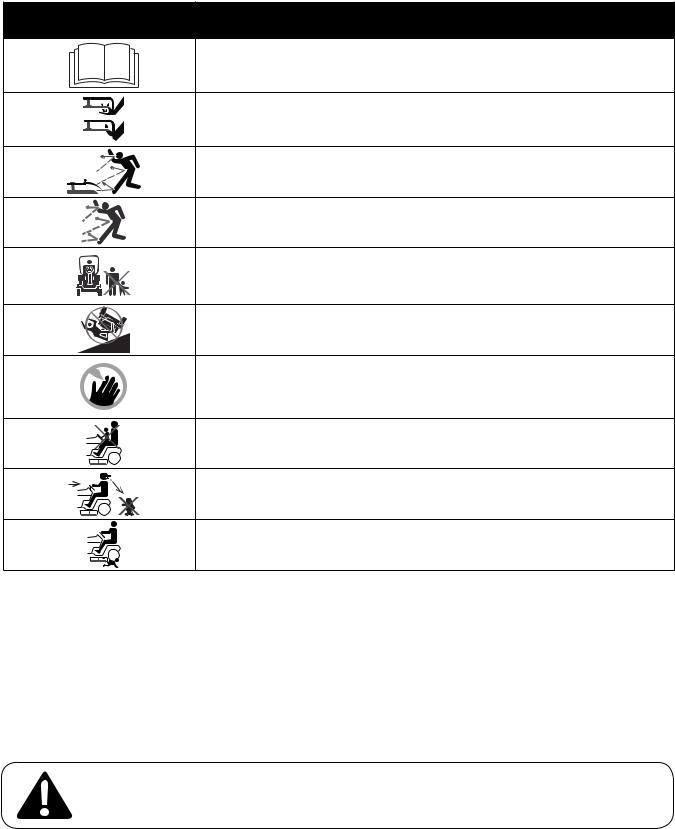
Safety Symbols
This page depicts and describes safety symbols that may appear on this product. Read, understand, and follow all instructions on the machine before attempting to assemble and operate.
Symbol |
Description |
READ THE OPERATOR’S MANUAL(S)
Read, understand, and follow all instructions in the manual(s) before attempting to assemble and operate
WARNING— ROTATING BLADES
Do not put hands or feet near rotating parts or under the cutting deck. Contact with the blade(s) can amputate hands and feet.
WARNING—THROWN OBJECTS
This machine may pick up and throw objects which can cause serious personal injury.
WARNING—THROWN OBJECTS
This machine may pick up and throw objects which can cause serious personal injury.
BYSTANDERS
Keep bystanders, helpers, children and pets at least 75 feet from the machine while it is in operation.
WARNING— SLOPE OPERATION
Do not operate this machine on a slope greater than 15 degrees.
MAX 

DANGER — ROTATING BLADES
To reduce the risk of injury, keep hands and feet away. Do not operate unless discharge cover or grass catcher is in its proper place. If damaged, replace immediately.
DANGER — ROTATING BLADES
Never carry passengers. Never carry children, even with the blades off.
DANGER — ROTATING BLADES
Always look behind and down for small children. Use slow speed.
DANGER — ROTATING BLADES
To avoid back-over accidents, keep children away from the machine while it is in operation.
WARNING! Your Responsibility—Restrict the use of this power machine to persons who read, understand and follow the warnings and instructions in this manual and on the machine.
SAVE THESE INSTRUCTIONS!
Section 2 — Important Safe Operation Practices |
|
7 |
|
||
|
|
|
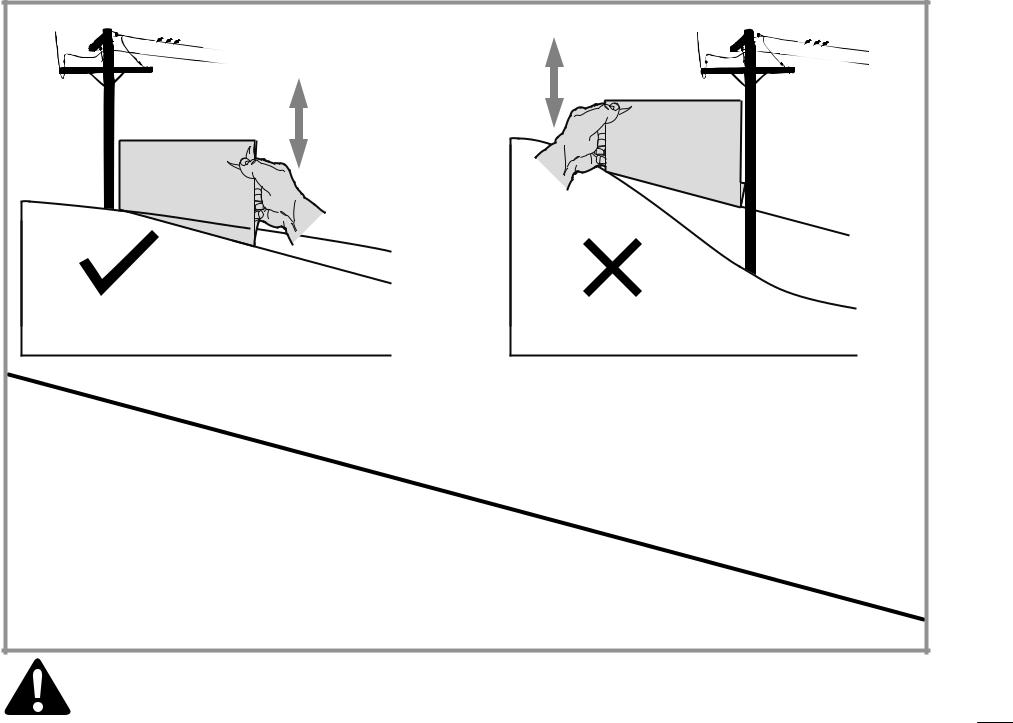
Slope Gauge
15° Slope
(OK)
Slope |
(TOO STEEP) |
Figure 1 |
Figure 2 |
15°
dashed line
USE THIS SLOPE GAUGE TO DETERMINE
IF A SLOPE IS TOO STEEP FOR SAFE OPERATION!
To check the slope, proceed as follows:
1.Remove this page and fold along the dashed line.
2.Locate a vertical object on or behind the slope (e.g. a pole, building, fence, tree, etc.)
3.Align either side of the slope gauge with the object (See Figure 1 and Figure 2 ).
4.Adjust gauge up or down until the left corner touches the slope (See Figure 1 and Figure 2).
5.If there is a gap below the gauge, the slope is too steep for safe operation (See Figure 2 above).
WARNING! Slopes are a major factor related to tip-over and roll-over accidents which can result in severe injury or death. Do not operate machine on slopes in excess of 15 degrees. All slopes require extra caution.
Always mow across the face of slopes, never up and down slopes.
Section 2 — Safe Operation Practices
8
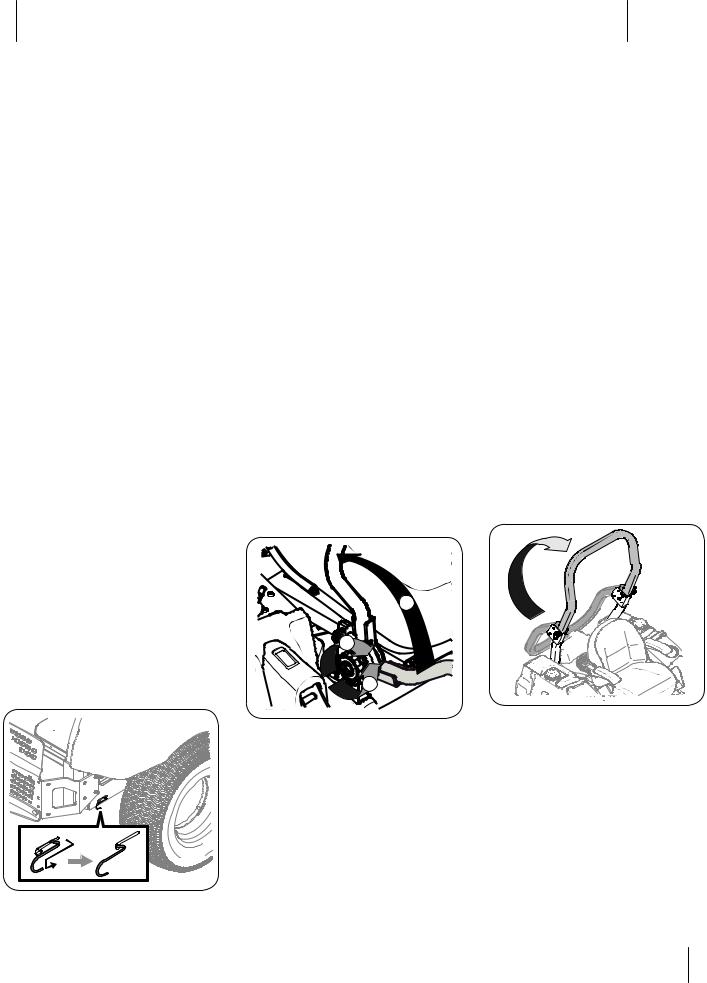
Assembly & Set-Up
Thank You
Thank you for purchasing this product. It was carefully engineered to provide excellent performance when properly operated and maintained.
Please read this entire manual prior to operating the equipment. It instructs you how to safely and easily set up, operate and maintain your machine. Please be sure that you, and any other persons who will operate the machine, carefully follow the recommended safety practices at all times. Failure to do so could result in personal injury or property damage.
All information in this manual is relative to the most recent product information available at the time. Review this manual frequently to familiarize yourself with the machine, its features and operation. Please be aware that this Operator’s Manual may cover a range of product specifications for various models. Characteristics and features discussed and/or illustrated in this manual may not be applicable to all models. We
reserve the right to change product specifications, designs and equipment without notice and without incurring obligation.
2
If applicable, the power testing information used to establish the power rating of the engine equipped on this machine can be found at www.opei.org or the engine manufacturer’s web site.
If you have any problems or questions concerning the machine, phone your local authorized service dealer or contact us directly. We want to ensure your complete satisfaction at all times.
Throughout this manual, all references to right and left side of the machine are observed from the operating position.
Contents of Carton
• |
Tractor (1) |
• |
Operator’s Manual (1) |
• |
Engine Operator’s Manual (1) |
NOTE: This Operator’s Manual covers several models. Features may vary by model. Not all features in this manual are applicable to all models and the model depicted may differ from yours.
NOTE: All references in this manual to the left or right side and front or back of the tractor are from the operating position only. Exceptions, if any, will be specified.
Tractor Preparation
Lubrication & Grease Points
Before operating the tractor, refer to the Service section of this manual to check the Lubrication & Grease Points. Grease and lubricate if necessary.
Manually Moving the Tractor
1.Engage the transmission bypass rods, one on each side of the tractor, to move the tractor manually without starting it. The transmission bypass rods are located on the rear of the tractor, just inside each rear wheel. Place the lapbars in the neutral (fully inward) position to disengage the parking brake. Engage the bypass rods by pulling each one back (a) and hooking it into the slot (b) to lock it into place. See Figure 2-1.
a b
Figure 2-1
2.Disengage the bypass rods by reversing steps a & b after moving the tractor. See Figure 2-1.
Position Drive Control Levers (if necessary)
The drive control levers of the tractor are lowered for shipping purposes. The levers must be repositioned to operate the tractor. To reposition the control levers for operation, proceed as follows:
1.Loosen the control lever knobs on the side of the drive control levers. See Figure 2-2.
2
2
1
Figure 2-2
2.Lift and swing that control lever upward into the desired position and secure in place by tightening the control lever knob. See Figure 2-2.
3.Note the relative position of the control lever to the pivot bracket, then repeat the previous steps to reposition the other control lever in approximately the same position.
4.Refer to “Adjusting the Drive Control Levers” on page 20 for instructions on the final adjustment of the levers.
Positioning the Roll Over Protective System (ROPS) (If necessary)
The ROPS is shipped folded down for shipping purposes. To place the ROPS into the operation position proceed as follows.
1.Remove the left and right clevis pins and cotter pins securing the ROPS in position and rotate it so that they allow the ROPS to move freely. See Figure 2-3.
Figure 2-3
2.Rotate to ROPS forward and re-insert the clevis pins and cotter pins to secure the ROPS in the operating position.
Adjusting the Seat
This tractor is equipped with an adjustable seat, which includes a retractable seat belt assembly and an Operator Presence Sensor (OPS). The OPS in the form of a switch, is integrated into the seat bottom and is
connected to the machine electrical system.
The seat can be adjusted forward and back and the arm rest can be adjusted up and down.
9
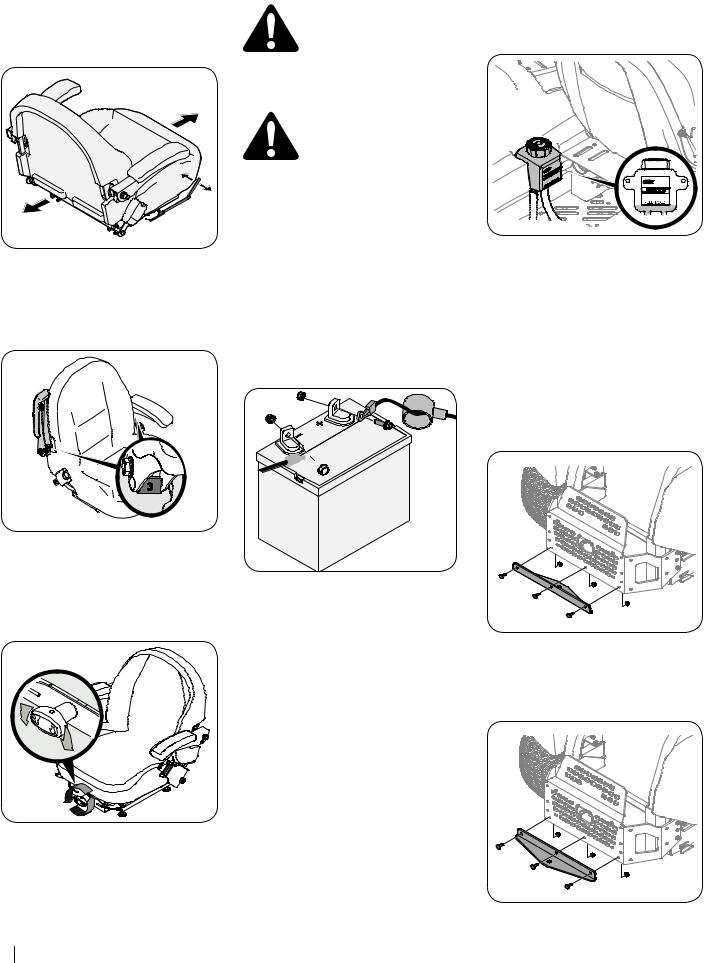
To move the seat forward or back, locate the seat adjustment rod under the seat. Push the rod to the left and slide the seat forward or back into the desired position and release the rod when the seat is in the desired position. See Figure 2-5.
Figure 2-4
To adjust the arm rest, lift the arm rest and rotate the block adjustment into one of the four positions (0-3, 0 being the lowest and 3 being the highest.) and lower the arm rest. See Figure 2-6.
Figure 2-5
The mechanical suspension mechanism (if equipped) incorporates weight/ride adjustment controls for operators in the 125 to 275 lb. weight range (turn the knob on the front of the seat clockwise to increase the weight capacity and counter-clockwise to decrease. See Figure 2-7.
Figure 2-6
NOTE: The seat base must be secured by the latch, otherwise, the seat assembly could tilt forward. The Operator Presence Sensor must be connected to the electrical wiring harness.
Connecting the Battery Cables
CALIFORNIA PROPOSITION 65 WARNING! Battery posts, terminals, and related
accessories contain lead and lead compounds, chemicals known to the State of California to cause cancer and reproductive harm. Wash hands after handling.
CAUTION: When attaching battery cables, always connect the POSITIVE (Red) wire to its
terminal first, followed by the NEGATIVE (Black) wire.
For shipping reasons, both battery cables on your equipment may have been left disconnected from the terminals at the factory. To connect the battery cables, proceed as follows:
NOTE: The positive battery terminal is marked Pos. (+). The negative battery terminal is marked Neg. (–).
NOTE: If the positive battery cable is already attached, skip ahead to step 2.
1.Remove the plastic cover, if present, from the positive battery terminal and attach the red cable to the positive battery terminal (+) with the bolt (a) and hex nut
(b). See Figure 2-8.
Under normal operating conditions, no oil should be added to the reservoir. The COLD oil level should be no higher than approximately 1⁄4” (the “Full Cold” mark) above the bottom of the reservoir. See Figure 2-9.
Figure 2-8
NOTE: Prior to the initial operation of the tractor, the oil level in the reservoir may be slightly higher than the maximum due to air in the oil lines. Operation of the tractor will eventually purge the air from the lines and the oil level will settle to the maximum.
Install the Rear Hitch Bracket (If necessary)
|
(b) |
1. |
Remove the hex flange screws (a) and |
(b) |
|
flange lock nuts (b) that secure the |
|
(a) |
(c) |
hitch bracket (c) to the bumper bracket. |
|
|
See Figure 2-10. |


 (a)
(a)
|
positive battery terminal to help protect |
c |
flange screws (a) and flange lock nuts (b) |
|
|
it from corrosion. |
|||
|
|
removed in step 1. |
||
|
|
a |
|
b |
|
Figure 2-7 |
|
a |
b |
2. |
Remove the plastic cover, if present, from |
|
a |
b |
|
the negative battery terminal and attach |
|
|
|
|
the black cable to the negative battery |
|
|
|
|
terminal (–) with the bolt (a) and hex nut (b). |
|
|
Figure 2-9 |
|
See Figure 2-8. |
2. |
Install the hitch bracket (c) as shown |
|
3. |
Position the red rubber boot (c) over the |
|
in Figure 2-11 and secure with the hex |
|
|
|
|
||
NOTE: If the battery is put into service after the date shown on top/side of battery, charge the battery as instructed in “Charging the Battery” on page 22 prior to operating the tractor.
Transmission Oil Expansion Reservoir
The transmission oil expansion reservoir |
c |
|
|
is connected by hoses to the RH and LH |
|
|
|
transmission assemblies, and is located behind |
a |
|
b |
the seat box. The function of the reservoir is |
a |
|
b |
to hold the natural expansion of transmission |
|
||
|
a |
b |
|
oil that occurs as the transmission warms up |
|
||
|
|
||
during operation. DO NOT FILL THE RESERVOIR. |
|
|
|
|
|
|
Figure 2-10 |
10 Section 2 — Assembly & Set-Up
